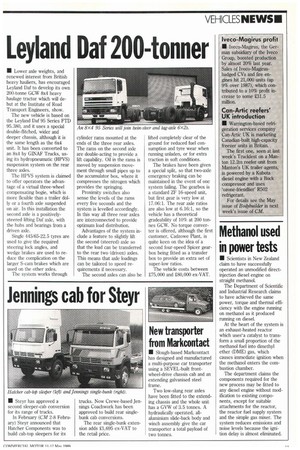Leyland Daf 200-tonner
Page 15

If you've noticed an error in this article please click here to report it so we can fix it.
• Lower axle weights, and renewed interest from British heavy hauliers, has encouraged Leyland Daf to develop its own 200-tonne GCW 8x4 heavy haulage tractor which will debut at the Institute of Road Transport Engineers, show.
The new vehicle is based on the Leyland Daf 95 Series FTD 95.380, and it uses a special double-flitched, wider and deeper chassis, although it is the same length as the 6x4 unit. It has been converted to an 8x4 by GINAF Trucks, using its hydropneumatic (HPVS) suspension system on the rear three axles.
The HPVS system is claimed to offer operators the advantage of a virtual three-wheel compensating bogie, which is more flexible than a trailer dolly or a fourth axle suspended on air. In this installation the second axle is a positivelysteered lifting Daf axle, with the hubs and bearings from a driven axle.
Single 445/65-22.5 tyres are used to give the required steering lock angles, and wedge brakes are used to reduce the complication on the larger S-cam brakes which are used on the other axles.
The system works through cylinder rams mounted at the ends of the three rear axles. The rams on the second axle are double-acting to provide a lift capability. Oil in the rams is moved by suspension movement through small pipes up to the accumulator box, where it compresses the nitrogen which provides the springing.
Proximity switches also sense the levels of the rams every five seconds and the system is levelled accordingly. In this way all three rear axles are interconnected to provide optimum load distribution.
Advantages of the system include a feature to slightly lift the second (steered) axle so that the load can be transferred to the rear two (driven) axles. This means that axle loadings can be tailored to speed requirements if necessary.
The second axles can also be lifted completely clear of the ground for reduced fuel consumption and tyre wear when running unladen, or for extra traction in soft conditions.
The brakes have been given a special split, so that two-axle emergency braking can be maintained in the event of one system failing. The gearbox is a standard ZF I6-speed unit, but first gear is very low at 17.06:1. The rear axle ratios are also low at 6.16:1, so the vehicle has a theoretical gradeability of 10% at 200 tonnes GCW. No torque converter is offered, although the first customer, Cadzowe Plant, is quite keen on the idea of a second four-speed Spicer gearbox being fitted as a transfer box to provide an extra set of super-low ratios.
The vehicle costs between £75,000 and £80,000 ex-VAT.
























































































































